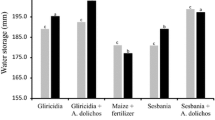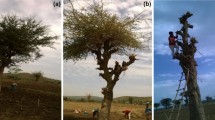Abstract
Using foliage of woody species as soil cover (SC) in agroforestry systems is an agroecological technique which may help to confront great challenges to food production, including conservation of soil moisture, provision of nutrients to the soil, and weed control. This study evaluated the effect of adding foliage of Leucaena leucocephala and Guazuma ulmifolia as SC on diversity, abundance, biomass, and potential for suppression of weeds. Eight treatments were established based on addition or not of foliage of woody species as SC to maize crop between alleys of the woody species. Richness, density, diversity, and production of weed biomass at 35, 65, and 95 days after germination of maize were recorded, and the potential for weed suppression was calculated. The study identified 47 weed species belonging to 18 families; no significant effect of addition of foliage on diversity and density of weeds was found. Production of biomass was significantly greater in the control treatment without woody species or SC than in the other treatments, while the greatest potential for suppression (40%) was found for the treatment with SC of foliage of both woody species. It was concluded that addition of foliage of L. leucocephala and G. ulmifolia as SC reduces weed biomass, increasing potential for weed suppression. Therefore, use of foliage of these species in alley crop** agroforestry systems contributes to weed control.






Similar content being viewed by others
References
Altieri M, Nicholls C (2004) Una base agroecológica para el diseño de sistemas diversificados de cultivo en el Trópico. Integr Pest Manag 73:8–20
Álvarez-Solís JD, Muñoz-Arroyo R, Huerta-Lwanga E, Nahed-Toral J (2016) Partial nitrogen balance in a corn (Zea mays L.) crop** system with legume cover in Chiapas, Mexico. Agron Costarric 40:29–39. https://doi.org/10.15517/rac.v40i1.25322
Atangana A, Khasa D, Chang S, Degrande A (2014) Agroforestry for soil conservation. In: Atangana A, Khasa D, Chang S, Degrande A (eds) Tropical agroforestry. Springer, pp 203–216
Bautista F, Frausto O, Ihl T, Aguilar Y (2015) An update soil map of the Yucatán state, Mexico: geomorphopedological approach and WBR. Ecosist Rec Agro 2:303–315
Bhaskar V, Westbrook A, Belliender R, Ditommaso A (2021) Integrated management of living mulches for weed control: A review. Weed Techonol 35:856–868. https://doi.org/10.1017/wet.2021.52
Boinot S, Fried G, Storkey J, Metcalfe H, Barkaoui K, Lauri P-É, Mézière D (2019) Alley crop** agroforestry systems: Reservoirs for weeds or refugia for plant diversity? Agric Ecosyst Environ 284:106584. https://doi.org/10.1016/j.agee.2019.106584
Bourgeois B, Munoz F, Fried G, Mahaut L, Armengot L, Denelle P, Storkey J, Gaba S, Violle C (2019) What makes a weed a weed? A large-scale evaluation of arable weeds through a functional lens. Am J Bot 106:90–100. https://doi.org/10.1002/ajb2.1213
Caamal-Maldonado J, Casanova-Lugo F, Gallegos M, Tzuc-Martínez R (2019) Productive and ecological aspects of integrated agroforestry systems with corn and forage tree species. In: Rodríguez A, Vergara S, Carmen M (eds) Ecological productive restoration, 1st edn. Xalapa, Veracruz, México, pp 75–95
Cabrera-Pérez C, Llorens J, Escola A, Royo-Esnal A, Recasens J (2023) Organic mulches as an alternative for under-vine weed management in Mediterranean irrigated vineyards: Impact on agronomic performance. Eur J Agron 145:126798. https://doi.org/10.1016/j.eja.2023.126798
Casanova-Lugo F, Petit-Aldana J, Solorio-Sánchez F, Parsons D, Ramírez-Avilés L (2014) Forage yield and quality of Leucaena leucocephala and Guazuma ulmifolia in mixed and pure fodder banks systems in Yucatan, Mexico. Agrofor Syst 88:29–39. https://doi.org/10.1007/s10457-013-9652-7
Casanova-Lugo F, Lara-Pérez L, Dzib-Castillo B, Caamal-Maldonado J, Ramírez-Barajas P, Cetzal W, Estrada H (2023) Alley crop** agroforestry systems change weed community composition and reduce dominant weed species associated with corn in southern Mexico. Agri Ecosy Envi 350:108471. https://doi.org/10.1016/j.agee.2023.108471
Chao A, Chiu CH, Jost L (2016) Phylogenetic diversity measures and their decomposition: a framework based on hill numbers. In: Pellens R, Grandcolas P (eds) Topics in biodiversity and conservation, Springer, pp 141–172
CICY (2010) Flora of the Yucatan Peninsula from Accessed 4 October 2022. https://www.cicy.mx/sitios/floradigital/vegetacion.html
Finney DM, Murrell EG, White CM, Baraibar B, Barbercheck ME, Bradley BA, Cornelisse S, Hunter MC, Kaye JP, Mortensen DA (2017) Ecosystem services and disservices are bundled in simple and diverse cover crop** systems. Agric Environ Lett 2(1):170–175. https://doi.org/10.2134/ael2017.09.0033
Flores A, Deniau Y (2019) The megaproject for the Yucatan Peninsula from Accessed 4 June 2022. http://geocomunes.org/Analisis_PDF/AnalisisGeneralYucatan.pdf
Gaba S, Cheviron N, Perrot T, Piutti S, Gautier J-L, Bretagnolle V (2020) Weeds enhance multifunctionality in arable lands in south-west of France. Front Sustain Food Syst 4:71. https://doi.org/10.3389/fsufs.2020.00071
Gallagher RS, Fernandes ECM, McCallie EL (1999) Weed management through short-term improved fallows in tropical agroecosystems. Agrofor Syst 47:197–221. https://doi.org/10.1023/A:1006271614502
Garnier E, Navas ML (2012) A trait-based approach to comparative functional plant ecology: concepts, methods and applications for agroecology. Agron Sustain Dev 32:365–399. https://doi.org/10.1007/s13593-011-0036-y
Hsieh TC, Ma KH, Chao A (2020) iNEXT: iNterpolation and EXTrapolation for species diversity. R package version 2020. http://chao.stat.nthu.edu.tw/wordpress/software-download/
Kass D, Jiménez Burgos JM, Schlonvoigt A (1997) How to make alley crop** more productive, sustainable, and acceptable to smallholders. Agrofor Am 4(14):21–23
Kikon G, Bhardwaj DR, Thakur CL (2017) Turmeric cultivation under bamboo-based agroforestry system-Effect of bamboo species and mulch material on weeds and soil characteristics. Indian J Agrofor 19(2):65–71
Koyejo AO, Okpara DA, Agugo BAC (2021) Effect of alley crop** on soil, maize and mungbean grown under different maize spatial arrangements and mungbean spacings in southeast Nigeria. Agrofor Syst. https://doi.org/10.1007/s10457-021-00635-5
Ku-Pech EM, Mijangos-Cortés JO, Andueza-Noh RH, Chávez-Pesqueira M, Simá-Polanco P, Simá-Gómez JL, Arias-Reyes LM (2019) Management strategies for the Mayan milpa in Xoy Peto Yucatan. Ecosyst Agric Resour. https://doi.org/10.19136/era.a7n1.2244
Lenth R (2022) Emmeans: estimated marginal means, aka Least-Squares Means. R package version 1.7.5. https://CRAN.R-project.org/package=emmeans
MacLaren C, Storkey J, Menegat A, Metcalfe H, Dehnen-Schmutz K (2020) An ecological future for weed science to sustain crop production and the environment. A review. Agron Sustain Dev 40:24–32. https://doi.org/10.1007/s13593-020-00631-6
Mohler CL, Liebman M, Staver CP (2001) Weed life history: identifying vulnerabilities. In: Lienman M, Mohler CL, Staver CP (eds) Ecological management of agricultural weeds. Cambridge, pp 40–98
Muñoz R, Pitty A (1994) Guía fotográfica para la identificación de malezas parte 1. Escuela agricola panamericana. San Antonio de Oriente, Honduras
Muschler RG (2016) Agroforestry: Essential for sustainable and climate-smart land use? In: Pancel L, Köhl M (eds) Tropical forestry handbook. Springer, pp 2013–2116
Oerke E-C (2006) Crop losses to pests. J Agric Sci 144(1):31–43. https://doi.org/10.1017/S0021859605005708
Oksanen J, Blanchet F, Friendly M, Kindt R, Legendre P, McGlinn D, Minchin P, O’Hara P, Simpson G, Solymos P (2019) Vegan: Community Ecology Package. R package version 2.5–6
Petit-Aldana J, Uribe-Valle G, Casanova-Lugo F, Solorio-Sánchez J, Ramírez-Avilés L (2012) Descomposition and nutrient release patterns of leaves of Leucaena leucocephala (Lam.), Guazuma ulmifolia Lam. and Moringa oleifera Lam. in a mixed fodder bank. Cha**o Ser for Environ Sci 18(1):5–25. https://doi.org/10.5154/r.rchscfa.2011.03.025
Quinkenstein A, Tsonkova P, Freese D (2017) Alley crop** with short rotation coppices in the temperate region: a land-use strategy for optimizing microclimate, soil organic carbon and ecosystem service provision of agricultural landscapes. In: Dagar J, Tewari V (ed) Agroforestry. Springer, pp 263–297
R Core Team (2023) R: A language and environment for statistical computing. https://www.r-project.org/
Rippin M, Haggar JP, Kass D, Köpke U (1994) Alley crop** and mulching with Erythrina poeppigiana (Walp.) O. F. Cook and Gliricidia sepium (Jacq.) Walp.: effects on maize/weed competition. Agrofor Syst 25:119–134. https://doi.org/10.1007/BF00705672
Rouge A, Adeux G, Busset H, Hugard R, Martin J, Matejicek A, Moreau D, Guillemin J-P, Cordeau S (2022) Weed suppression in cover crop mixtures under contrasted levels of resource availability. Eur J Agron 136:126499. https://doi.org/10.1016/j.eja.2022.126499
Sjursen H, Brandsæter LO, Netland J (2012) Effects of repeated clover undersowing, green manure ley and weed harrowing on weeds and yields in organic cereals. Acta Agric Scand B Soil Plant Sci 62(2):138–150. https://doi.org/10.1080/09064710.2011.584550
Trinder CJ, Brooker RW, Davidson H, Robinson D (2021) Directly quantifying multiple interacting influences on plant competition. Plant Cell Environ 44(4):1268–1277. https://doi.org/10.1111/pce.13944
Tzuc-Martínez R, Casanova-Lugo F, Caamal-Maldonado A, Tun-Garrido J, González-Valdivia N, Cetzal-Ix W (2017) Influence of woody species in the dynamics of weeds in agroforestry systems in Yucatan, Mexico. Agrociencia 51:315–328
Vavrek MJ (2011) Fossil: palaeoecological and palaeogeographical analysis tools. Palaeontol Electron 14(1):16
Wang L, Gruber S, Claupein W (2012) Optimizing lentil-based mixed crop** with different companion crops and plant densities in terms of crop yield and weed control. Org Agric 2:79–87. https://doi.org/10.1007/s13165-012-0028-5
Wilen CA, Schuch UK, Elmore CL (1999) Mulches and subirrigation control weeds in container production. J Environ Hortic 17(4):174–180. https://doi.org/10.24266/0738-2898-17.4.174
Acknowledgements
We would like to thank the Ciencias Biológicas y Agropecuarias Campus of the Universidad Autónoma de Yucatán, El Colegio de la Frontera Sur (ECOSUR), and the Centro de Investigación Científica de Yucatán for support for this study.
Funding
This project was partially funded by ECOSUR (fiscal project 3102411979). PAXC received a doctoral fellowship (686632) from Mexico´s Consejo Nacional de Ciencia y Tecnología (CONACyT).
Author information
Authors and Affiliations
Contributions
PAXC designed the experiment, carried out fieldwork and data analysis, and was the principal author of the article. MJCP supervised and contributed to fieldwork, supervised data analysis, and coordinated writing of the article. JDAS designed the experiment, and together with JMV and JMPF participated in data analysis and writing of the article.
Corresponding author
Ethics declarations
Competing interests
The authors declare no competing interests.
Conflict of interest
The authors declare they have no potential conflict of interest.
Ethical approval
Not applicable.
Consent to participate
Not applicable.
Consent for publication
Not applicable.
Additional information
Publisher's Note
Springer Nature remains neutral with regard to jurisdictional claims in published maps and institutional affiliations.
Supplementary Information
Below is the link to the electronic supplementary material.
Rights and permissions
Springer Nature or its licensor (e.g. a society or other partner) holds exclusive rights to this article under a publishing agreement with the author(s) or other rightsholder(s); author self-archiving of the accepted manuscript version of this article is solely governed by the terms of such publishing agreement and applicable law.
Received:
Accepted:
Published:
Issue Date:
DOI: https://doi.org/10.1007/s10457-023-00880-w




